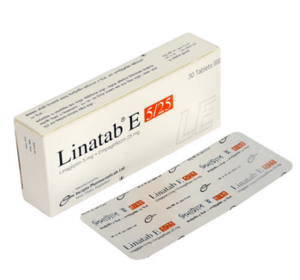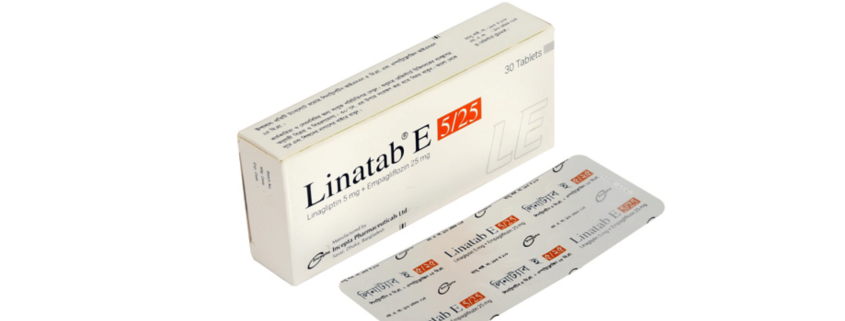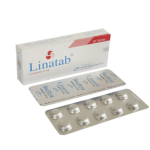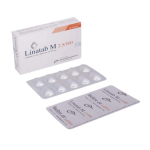Linatab E(Linagliptin + Empagliflozin)
Therapeutic Group: Anti Diabetic
Presentation

Linatab E 5/10: Each tablet contains Linagliptin INN 5 mg and Empagliflozin INN 10 mg.
Linatab E 5/25: Each tablet contains Linagliptin INN 5 mg and Empagliflozin INN 25 mg.
Description
Linatab E is a combination of two oral antihyperglycemic drugs with complimentary mechanism of action to improve glycemic control in patients with type-2 diabetes mellitus: Linagliptin, a Dipeptidyl Peptidase-4 (DPP-4) inhibitor and Empagliflozin, a sodium-glucose co-transporter 2 (SGLT2) inhibitor.
Linagliptin exerts its action by slowing the inactivation of incretin hormones. Incretin hormone levels are increased in response to a meal. When blood glucose concentrations are normal or elevated, incretin hormones increase insulin synthesis and release from pancreatic beta cells. Incretin hormones also lowers glucagon secretion from pancreatic alpha cells, leading to reduced hepatic glucose production.
By inhibiting SGLT2, Empagliflozin reduces renal reabsorption of filtered glucose and lowers the renal threshold for glucose, and thereby increases urinary glucose excretion.
Indications
Linagliptin + Empagliflozin combination is indicated as an adjunct to diet and exercise to improve glycemic control in adults with type 2 diabetes mellitus when treatment with both Linagliptin and Empagliflozin is appropriate.
Limitations of use:
– Not for the treatment of type 1 diabetes mellitus or diabetic ketoacidosis
– Has not been studied in patients with a history of pancreatitis
Dosage & Administration
– The recommended dose of LINATAB E is 5 mg Linagliptin/10 mg Empagliflozin once daily, taken in the morning, with or without food
– Dose may be increased to 5 mg Linagliptin/25 mg Empagliflozin once daily
– Assess renal function before initiating Linagliptin + Empagliflozin combination. Do not initiate this drug if eGFR is below 45 mL/min/1.73 m2 – Discontinue Linagliptin + Empagliflozin combination if eGFR falls persistently below 45 mL/min/1.73 m2
Side Effects
The most common adverse reactions associated with Linagliptin + Empagliflozin combination (a 5% or greater incidence) were urinary tract infections, nasopharyngitis, and upper respiratory tract infections.
Precautions
Pancreatitis: There have been postmarketing reports of acute pancreatitis, including fatal pancreatitis. If pancreatitis is suspected, promptly discontinue Linagliptin + Empagliflozin combination.
Hypotension: Before initiating this combination assess and correct volume status in patients with renal impairment, the elderly, in patients with low systolic blood pressure, and in patients on diuretics. Monitor for signs and symptoms during therapy.
Impairment in Renal Function: Monitor renal function during therapy. More frequent monitoring is recommended in patients with eGFR below 60 mL/min/1.73 m2.
Hypoglycemia: Consider lowering the dose of insulin secretagogue or insulin to reduce the risk of hypoglycemia when initiating Linagliptin + Empagliflozin combination.
Genital Mycotic Infections: Monitor and treat as appropriate.
Urinary Tract Infections: Monitor and treat as appropriate.
Hypersensitivity: There have been postmarketing reports of serious hypersensitivity reactions in patients treated with Linagliptin (one of the
components of Linagliptin + Empagliflozin combination) including anaphylaxis, angioedema, and exfoliative skin conditions. In such cases,
promptly discontinue Linagliptin + Empagliflozin combination, assess for other potential causes, institute appropriate monitoring and treatment
and initiate alternative treatment for diabetes.
Increased LDL-C: Monitor and treat as appropriate.
Macrovascular Outcomes: There have been no clinical studies establishing conclusive evidence of macrovascular risk reduction with
Linagliptin + Empagliflozin combination or any other antidiabetic drug.
Use in Pregnancy & Lactation
Pregnancy: There are no adequate and well-controlled studies in pregnant women. Use during pregnancy only if the potential benefit justifies
the potential risk to the fetus.
Nursing Mothers: Discontinue Linagliptin + Empagliflozin combination or discontinue nursing.
Pediatric Patients: Safety and effectiveness of Linagliptin + Empagliflozin combination in pediatric patients have not been established.
Geriatric Patients: Higher incidence of adverse reactions related to volume depletion and reduced renal function.
Drug Interaction
Drug Interactions with Empagliflozin:
Diuretics: Coadministration of empagliflozin with diuretics resulted in increased urine volume and frequency of voids, which might enhance the
potential for volume depletion.
Insulin or Insulin Secretagogues: Coadministration of Empagliflozin with insulin or insulin secretagogues increases the risk for hypoglycemia.
Positive Urine Glucose Test: Monitoring glycemic control with urine glucose tests is not recommended in patients taking SGLT2 inhibitors as
SGLT2 inhibitors increase urinary glucose excretion and will lead to positive urine glucose tests. Use alternative methods to monitor glycemic
control.
Drug Interactions with Linagliptin:
Inducers of P-glycoprotein or CYP3A4 Enzymes: Rifampin decreased Linagliptin exposure, suggesting that the efficacy of Linagliptin may be
reduced when administered in combination with a strong P-gp or CYP3A4 inducer. Therefore, use of alternative treatments is strongly
recommended when Linagliptin is to be administered with a strong P-gp or CYP3A4 inducer.
Over Dose
In the event of an overdose with Linagliptin + Empagliflozin combination, contact the Poison Control Center. Employ the usual supportive
measures (e.g., remove unabsorbed material from the gastrointestinal tract, employ clinical monitoring, and institute supportive treatment) as
dictated by the patient’s clinical status. Removal of Empagliflozin by hemodialysis has not been studied, and removal of Linagliptin by
hemodialysis or peritoneal dialysis is unlikely.
Storage
Do not store above 30 0C. Keep out of the reach of children.
Commercial Pack
Linatab E 5/10: Each box contains 3 blister strips of 10 tablets.
Linatab E 5/25: Each box contains 3 blister strips of 10 tablets



